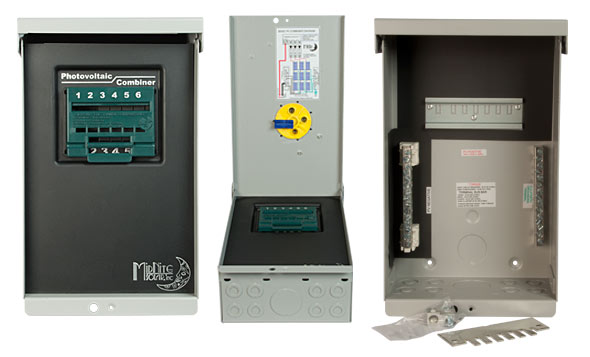
Let’s assume we have a system with three of the following panels on a single series string:
Canadian Solar CS6P-255P 255W Poly Solar Panel
Panel Electrical Characteristics:
System Rating (STC): 255 Watts
Max Power Voltage (Vmp): 30.2 Volts
Max Power Current (Imp): 8.43 Amps
Open Circuit Voltage (Voc): 37.4 Volts
Short Circuit Current (Isc): 9 Amps
Series Fuse Rating: 15 Amps
Sizing the Charge Controller
The main criteria necessary to determine what charge controller is right for your application is the voltage and amperage rating. Each charge controller has a maximum volt and amp input and we need to make sure that the panels don’t exceed these inputs.
Voltage (Charge Controller)
Most charge controllers can take in a maximum of 150VDC per string. Some charge controllers, such as the Schneider MPPT 80 600 charge controller, can take in up to 600VDC. This greatly increases the max number of panels on a string and reduces Balance of System (BOS) costs, though 600V charge controllers are generally more expensive than standard 150VDC versions and are not as commonly used. Let’s assume for this application we’re using a 150VDC controller.
The formula for determining voltage compatibility in a charge controller is as follows:
(Panel Voc) x (# Panels in Series) x (Correction Factor from NEC 690.7*) < max input voltage of charge controller (either 150VDC or 600VDC)
Panel Voc: each panel will have a particular open circuit voltage (Voc). The example panel in this application has a Voc of 37.4VDC.
# Panels in Series: the most commonly used number of panels in a string in an off grid application with a 150VDC charge controller is 2 or 3 panels. (600VDC charge controllers can take approx. four times as many panels on a string).
*Correction Factor from NEC 690.7: this will vary depending on a location’s temperature from approximately 1.1-1.25. (i.e. record low temperature which will increase the panel voltage) When in doubt, use the more conservative 1.25 rating.
In this application, we have:
(37.4V) x (3) x (1.25) < 150VDC
140.25 < 150VDC CORRECT!
The maximum voltage of a string of (3) Canadian Solar 255W panels is 140.25, which is under the charge controller’s maximum voltage of 150VDC, so this is compatible!

Amperage (Charge Controller)
The next step is to verify compatibility of the array’s amperage with the charge controller. Each charge controller will have a specific maximum amperage that it can take in from the panels.
The formula for determining amperage compatibility is as follows:
(Panel Isc) x (# Strings in Parallel) x (1.25 Safety Factor) < Max amp input rating of charge controller (will vary depending on the model)
Panel Isc: each panel will have its own Short Circuit Current (Isc) rating. The Isc of the Canadian Solar 255P is 9A.
# Strings in Parallel: This example only has one string of three panels, though larger charge controllers such as the Outback FLEXmax 80 can take up to five strings of panels.
Safety Factor: A standard 1.25 safety factor to add an extra layer of assurance that the amperage will never spike above the charge controller’s rated capacity.
In the current application, we have
(9) x (1) x (1.25) < Max amp input
11.25 < Max amp input
Therefore, we need to find a charge controller that has a max amp rating of at least 11.25 and a standard max voltage rating of 150VDC.
Note that some manufacturers also have online sizing tools for their charge controllers. For example, Outback’s charge controller string sizing tool is accessible here.
Sizing the Combiner Box

We size the combiner box in nearly the exact same way as the charge controllers.
The formula for verifying voltage compatibility is identical:
(Panel Voc) x (# Panels in Series) x (Correction Factor from NEC 690.7*) < max input
Determining the fuse rating for the combiner is a bit different, because this time the rating is per string and not for all the panels feeding into the unit:
(Panel Isc) x (1.56 Safety Factor) < Fuse/circuit breaker rating (usually 15A)
For this application, we have:
(9) x (1.56) < Fuse/circuit breaker rating (usually 15A)
14.04 < Fuse/circuit breaker rating (usually 15A)